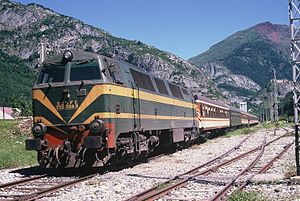RENFE Class 333
| RENFE Class 333 | |||||||||||||||||||||||||||||||||||||||
|---|---|---|---|---|---|---|---|---|---|---|---|---|---|---|---|---|---|---|---|---|---|---|---|---|---|---|---|---|---|---|---|---|---|---|---|---|---|---|---|

RENFE Class 333
|
|||||||||||||||||||||||||||||||||||||||
|
|||||||||||||||||||||||||||||||||||||||
|
|||||||||||||||||||||||||||||||||||||||
|
|||||||||||||||||||||||||||||||||||||||
|
|||||||||||||||||||||||||||||||||||||||
| Type and origin | |
|---|---|
| Power type | Diesel-electric |
| Designer |
Macosa, General Motors, Nohab Refurbishment : Alstom |
| Build date | Original series : 1974–1976 333.1 1994–1995 333.2 1997–1998 333.3 2002–2003 333.4 2003–2004 |
| Total produced | 333 (original) 93 333.1 8 333.2 4 333.3, 333.4 92 |
| Specifications | |
|---|---|
| Configuration: |
|
| • UIC | Co′Co′ |
| Gauge | 1,668 mm (5 ft 5 21⁄32 in) Iberian gauge |
| Bogies | General motors 'flexicoil' type |
| Length | Original 20.7 m (67 ft 11.0 in) 333.3/333.4 22.33 m (73 ft 3.1 in) |
| Width | Original 3.06 m (10 ft 0.47 in) 333.3/333.4 3.16 m (10 ft 4.41 in) |
| Height | Original 4.28 m (14 ft 0.50 in) 333.3/333.4 4.307 m (14 ft 1.57 in) |
| Axle load | 20 t (19.7 long tons; 22.0 short tons) |
| Loco weight | 120 t (118 long tons; 132 short tons) |
| Fuel type | Diesel |
| Fuel capacity | Original : 4,500 L (990 imp gal; 1,200 US gal) 333.3 : 7,200 L (1,600 imp gal; 1,900 US gal) (6,000 L or 1,300 imp gal or 1,600 US gal?) |
| Prime mover | General Motors GM 16-645-E-3 3,300 hp (2,500 kW) |
| Engine type | two-stroke diesel |
| Alternator | General Motors AR-10 / D-14 |
| Traction motors | Original 6 of GM D-77 RENFE 333.3 and 333.4 6 of D-78 |
| Cylinders | V16 |
| Transmission | Electric |
| Loco brake | Pneumatic and rheostatic |
| Performance figures | |
|---|---|
| Maximum speed | 333 (original) 146 km/h (91 mph) 333.1 160 km/h (99 mph) 333.2 140 km/h (87 mph) 333.3 120 km/h (75 mph) 333.4 160 km/h (99 mph) |
| Power output | Original 1,875 kW (2,514 hp) (nominal at rail) |
| Tractive effort |
Original |
| Career | |
|---|---|
| Operators | RENFE |
| Nicknames | Rambo (original build) |
| Locale | Spain |
Original
starting : 330 kN (74,000 lbf) at μ=0.28
continuous : 276 kN (62,000 lbf) at 23.5 km/h (14.6 mph)
topspeed : 47 kN (11,000 lbf) at 150 km/h (93 mph)
Rebuilt (333.3 and 333.4)
starting : 341 kN (77,000 lbf)
The RENFE Series 333 are high power six-axle diesel-electric locomotives built in the 1970s; at the time of their introduction they were the most powerful non-electric locomotives in Spain.
After three decades of service the class were rebuilt incorporating Alstom's newer technology, and thus extending their life - these rebuilt machines were given the sub-class names 333.3 and 333.4
In the early 1970s, RENFE was looking for a new, diesel-engined locomotive capable of both hauling express trains and high-tonnage heavy freight trains nationwide at a steady speed of 120 km/h (75 mph).
At the time, RENFE's dieselization program, with the 316 and 318 series CC locomotives, later followed by the more numerous 319 and 321, had displaced steam powered traction and were responsible for much of the work requiring higher-powered locomotives.
The Class 319, produced in collaboration between Macosa and General Motors, had shown good performance, which influenced the decision to choose a locomotive of the General Motors type GT 26, (3,300 hp (2,500 kW)).
In this series of locomotives, instead of taking the typical single cabin General Motors design it was decided to use a two cabined design; the Scandinavian manufacturer Nohab had also been producing GM engined locomotives (having acquired a license to produce GM engined locomotives of its own designs), and a model was chosen based on the JT-26 with the Nohab bi-cabin box (See DSB class MZ) which was used by the Danske Statsbaner (DSB).
RENFE chose the variant model MZ1 which had a power output of almost 4,000 hp (3,000 kW), they were also able to supply electrical train heating - a first in Spain.
The locomotives were equipped with General Motors engines, generators, traction motors and electrical equipment. The diesel engines are 45 degree offset 16 cylinder V engined, two-stroke designs (EMD 645), with a compression ratio of 14.5:1, and an engine displacement of 10.57 L (2.33 imp gal; 2.79 US gal).
...
Wikipedia
